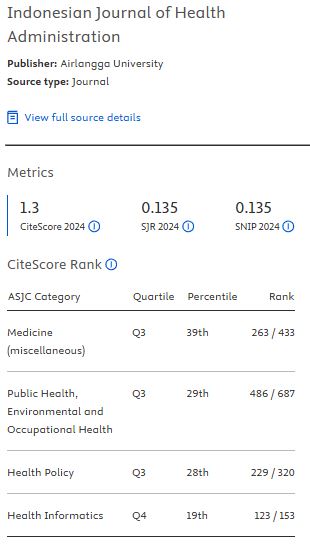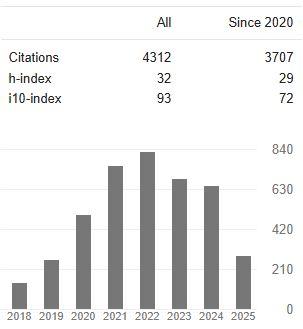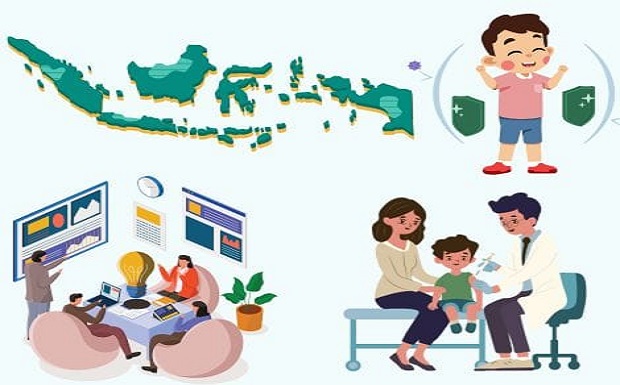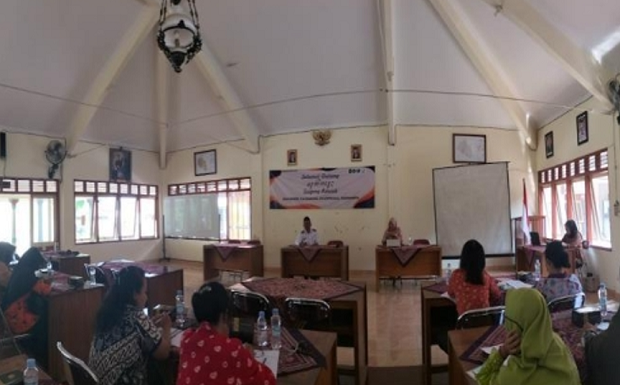Hubungan Karakteristik Individu terhadap Penilaian Kualitas Produk Apotek Rawat Jalan
Downloads
ABSTRACT
Pharmacy services in hospitals need special attention to achieve effectiveness and efficiency of quality dimensions. Achievement of customer satisfaction figures in Dr. Moewardi Pharmacy Hospital Surakarta didn't meet hospital standards that set in the amount of ≥ 80% over the years 2013 to 2014, especially in the outpatient pharmacy. The purpose of this research is to study the relationship between the individual factors of patient (age, sex, educational level, employment status, income level) to product quality assessment in an outpatient pharmacy. This research is an observational analytic with cross sectional study design. Data was collected by interview using a questionnaire. Analyzed using univariate and bivariate analysis. The Results of the analysis of the factor that were significantly associated with the assessment of product quality are age and employment status. The majority of respondents give high scores for product quality assessment. Individual patient factors associated with product quality assessment in outpatient pharmacies are age and employment status. Need to maintain the quality of existing products, and specifically to the dimensions of the product's features need to increase in order to better product quality.
Keywords: pharmacy services, individual factors, products quality
Anderson, E. W., Fomel, C., & Lehmann, D. R. (1994). Costumer Satisfaction, Market Share, and Profitability: Findings from Sweden). Journal of Marketing, 58 (3), 53-56.
Arifianti, R. (2013). Analisis Kualitas Produk Sepatu Tomkins pada PT. Primarindo Asia Infrastucture, Tbk Bandung. Jurnal Dinamika Manajemen, 4 (1).
Biel, A. L. (1992). How Brand Image Drives Brand Equity. Journal of Advertaising Research, 36 (6).
Brucks, M., Zeithaml, V. A., & Naylor, G. (2000). Price and Brand Name As Indicators of Quality Dimensions for Consumer Durables. Journal of the Academy of Marketing Science, 28, 359–374. doi: 10.1177/0092070300283005.
Dobni, D., & Zinkhan, G. M. (1990). In Search of Brand Image: A Foundation Analysis. Advances in Consumer Research, 17, 110-119.
Fuchs, V. R. (1998). Who Shall Live? Health, Economics, and Social Choice. Prentice Hall.
Heitmann, M., Lehmann, D. R., & Herrmann, A. (2007). Choice Goal Attaintment and Decision and Consumption Satisfaction. Jurnal of Marketing Research, 44, 234-250.
Heriyono. (2004). Faktor-Faktor yang Berhubungan dengan Kepatuhan Penderita Tuberkulosis Paru Melakukan Pemeriksaan Ulang Dahak pada Akhir Pengobatan Tahap Intensif di Puskesmas Wonosobo 1 Kabupaten Wonosobo. Thesis. Semarang: Universitas Diponegoro.
Hurriyati, R. (2005). Bauran Pemasaran & Loyalitas Konsumen. Bandung: Alfabeta.
Hutapea, N. O. (2009). Buku Ajar Ilmu Penyakit Kulit dan Kelamin: Sifilis. Jakarta: Balai Penerbitan FKUI.
Kanuk, L. L., & Schiffman, L. G. (2004). Perilaku Konsumen Edisi 7. Jakarta: Prentice Hall.
Koltler, P. (2004). Manajemen Pemasaran Jilid 2. Jakarta: PT. Indeks Kelompok Gramedia.
Kotler, P., & Keller, K. L. 2009. Manajemen Pemasaran Edisi 12 Jilid 1. Jakarta.
Kotler, P. (2001). Manajemen Pemasaran: Analisis, Perencanaan, Implementasi, dan Kontrol. Jakarta: PT. Prehallindo
Kotler, P., Bowen, J., & Makens, J. (2003). Markting for Hospitality & Tourism 3th edition. New Jersey: Prentice Hall.
Lamb, C. W., Hair, J. F., & Mcdaniel, C. (2001). Pemasaran Edisi Empat. Jakarta: Salemba Empat.
Menteri Kesehatan Republik Indonesia. (2004). Keputusan Menteri Kesehatan Republik Indonesia No 1197/MENKES/SK/X/2004 Tentang Standar Pelayanan Farmasi di Rumah Sakit.
Menteri Kesehatan Republik Indonesia. (2008). Keputusan Menteri Kesehatan Republik Indonesia No. 129/Menkes/SK/II/2008 Tentang Standar Minimal Pelayanan Rumah Sakit.
Mulyono, B. H., Yoestini, N. R., & Kamal, M. (2007). Analisis Pengaruh Kualitas Produk dan Kualitas Layanan terhadap Kepuasan Konsumen (Studi Kasus di Perumahan Puri Mediterania Semarang). Jurnal Manajemen dan Organisasi, 4 (2).
Notoatmodjo, S. (2003). Pendidikan dan Perilaku Kesehatan. Jakarta: Rineka Cipta.
Notoatmodjo, S. (2010). Ilmu Perilaku Kesehatan. Jakarta: Rineka Cipta.
Olson, J. C., & Peter, J. P. (2000). Consumer Behavior: Perilaku Konsumen dan Startegi Pemasaran. Jakarta: Erlangga.
Pasuraman. (1990). SERVQUAL: Review, Critique Research Agenda. European Journal of Marketing, 1-36.
Ruditya, D. N. (2014). Faktor yang Berhubungan dengan Kepatuhan Penderita Tuberkulosis untuk Memeriksakan Dahak Selama Pengobatan (Studi di Wilayah Kerja Puskesmas Tanah Kalikedinding Kota Surabaya). Skripsi. Surabaya: Universitas Airlangga.
Ruditya, A. N. (2015). Hubungan Faktor Individu dan Faktor Sosial terhadap Penilaian Dimensi Kualitas Produk Di Apotek Rawat Jalan (Instalasi Farmasi RSUD Dr. Moewardi Surakarta). Skripsi. Surabaya: Universitas Airlangga.
Schiffman, L. G., & Kanuk, L. L. (2000). Consumer Behavior 7th edition. New Jersey: Prentice Hall.
Sumarwan, U. (2004). Perilaku Konsumen. Bogor: Ghalia Indonesia.
Swatas, Basu, & Handoko, T. H. (2000). Analisa dan Perilaku Konsumen. Yogyakarta: BPFE.
Tjiptono, F. (2008). Strategi Pemasaran Edisi Ketiga. Yogyakarta: Andi.
Widyaswati, R. (2010). Analisis Faktor-Faktor yang Mempengaruhi Kepuasan sehingga Tercipta Word of Mouth yang Positif pada Pelanggan Speedy di Semarang. Tesis.Semarang: Universitas Diponegoro.
Wijaksana, A. (1992). Minat Remaja dalam Pemilihan Bidang Karir pada Status Sosial Ekonomi Keluarga Tingkat Atas, Menengah, dan Bawah. Skripsi. Jakarta: Universitas Indonesia.
Yulie, A. (2008). Persepsi terhadap Kualitas Produk "Daihatsu Xenia" dengan Kepuasan Konsumen. Skripsi. Semarang: Universitas Katolik Soegijaprenata.
Zeithaml, V. A., & Bitner, M. J. (2003). Services Marketing: Integrating Costumer Focus Across the Firm, 3rd Edition. Boston: McGraw Hill.
Zeithaml, V. A., & Bitner, M. J. (1996). Delivering and Performing Service. Boston: McGraw Hill.
Zelezny, L., & Schultz, P. W. (1999). Value as Predictor of Environmental Attitudes: Evidence for Consistency across 14 Countries. Journal of Environmental Psychology.
1. As an author you (or your employer or institution) may do the following:
- make copies (print or electronic) of the article for your own personal use, including for your own classroom teaching use;
- make copies and distribute such copies (including through e-mail) of the article to research colleagues, for the personal use by such colleagues (but not commercially or systematically, e.g. via an e-mail list or list server);
- present the article at a meeting or conference and to distribute copies of the article to the delegates attending such meeting;
- for your employer, if the article is a ‘work for hire', made within the scope of your employment, your employer may use all or part of the information in the article for other intra-company use (e.g. training);
- retain patent and trademark rights and rights to any process, procedure, or article of manufacture described in the article;
- include the article in full or in part in a thesis or dissertation (provided that this is not to be published commercially);
- use the article or any part thereof in a printed compilation of your works, such as collected writings or lecture notes (subsequent to publication of the article in the journal); and prepare other derivative works, to extend the article into book-length form, or to otherwise re-use portions or excerpts in other works, with full acknowledgement of its original publication in the journal;
- may reproduce or authorize others to reproduce the article, material extracted from the article, or derivative works for the author's personal use or for company use, provided that the source and the copyright notice are indicated.
All copies, print or electronic, or other use of the paper or article must include the appropriate bibliographic citation for the article's publication in the journal.
2. Requests from third parties
Although authors are permitted to re-use all or portions of the article in other works, this does not include granting third-party requests for reprinting, republishing, or other types of re-use.
3. Author Online Use
- Personal Servers. Authors and/or their employers shall have the right to post the accepted version of articles pre-print version of the article, or revised personal version of the final text of the article (to reflect changes made in the peer review and editing process) on their own personal servers or the servers of their institutions or employers without permission from JAKI;
- Classroom or Internal Training Use. An author is expressly permitted to post any portion of the accepted version of his/her own articles on the author's personal web site or the servers of the author's institution or company in connection with the author's teaching, training, or work responsibilities, provided that the appropriate copyright, credit, and reuse notices appear prominently with the posted material. Examples of permitted uses are lecture materials, course packs, e-reserves, conference presentations, or in-house training courses;
























